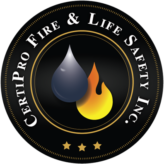Importance of an Audible and Visible Alarm Systems
One of the most essential functions of a monitored fire alarm is to alert local authorities that your building is in danger. The alarm’s built-in transmitter sends a message to the fire department when a smoke detector or fire sprinkler goes off, or if someone activates a pull station. As a result, a fire truck dispatches to your location immediately.
Of course, the other most important part of a fire alarm is to alert people in the building that they need to evacuate. To get the message across to everyone, your alarm system must feature both audible and visible cues. The Americans with Disabilities Act (ADA) requires it.
Incorporating sirens and strobe lights into your alarm system seems simple enough, but failing to meet highly specific regulations could result in your noncompliance. Here’s what you need to know.
Audible Fire Alarm Features
Loud sirens are a requisite part of any fire alarm system. The noise ensures that visually impaired people and those with limited hearing can still detect the need to evacuate. The ADA establishes several rules for audible fire alarms, including the following:
• Alarm noise levels can’t exceed 120 A-weighted decibels (dbA).
• Audible alarms must exceed the noise level in the room by 15dbA. If this causes the noise level to exceed 120dbA, the alarm may be only 5dbA louder, but it must sound off for at least 60 seconds.
• The sound of the alarm must be easy to distinguish from the prevailing noise in the room to prevent misinterpreting the alarm.
Visible Fire Alarm Features
Flashing lights and text banners are two examples of visible alarms. Their purpose is to catch people’s attention, even if any building occupants are deaf. ADA regulations state the following:
• Visible fire alarms must not be so intense that they’re unsafe to look at directly or increase the risk of seizures in people with photosensitive epilepsy. To help with this, all strobes visible from a single location must flash simultaneously.
• Flashing lights must be visible from any location in a room or hallway. To accomplish this, follow the guideline of installing visible alarms in 100-foot increments along the length of every hallway and within 15 feet of either end.
• To maximize visibility, flashing lights must be installed between 80 and 96 inches above the highest floor level in the room or 6 inches below the ceiling. In many cases, ceiling-mounted strobes are also code-compliant.
• Visible alarms must be clear or nominal white in color.
• Flashing strobes in an ordinary room or hallway may have a brightness rating of 15 candelas (cd), but for brightly lit areas, the lights may need to be more intense. In all cases, the intensity of visible alarms must not exceed 1,000 cd.
If you need help installing audible and visible alarm systems in your Arizona building, CertiPro Fire and Life Safety is here for you. We have over 20 years of fire protection experience and can help ensure ADA compliance.
If you need expert professional fire alarm services in Arizona, connect with CertiPro Fire & Life Safety. Our technicians have extensive experience in performing complete assessments on-site, and we have the expertise needed to recommend the ideal system that suits your property’s needs as well as your budget. We also provide installation, inspection, maintenance and repair services whenever needed.
Contact us to find out how we can help protect your commercial or residential property today.
Fire sprinkler services Scottsdale AZ , Mesa, Phoenix, and the surrounding Arizona region are provided by CertiPro Fire and Life Safety, Inc.
Fire Sprinkler Repair Services Mesa AZ , Scottsdale, Phoenix, and the surrounding Arizona region are provided by CertiPro Fire and Life Safety, Inc.
Fire alarm services Mesa, Phoenix, Scottsdale, Tempe, Gilbert, and the surrounding Arizona area.
